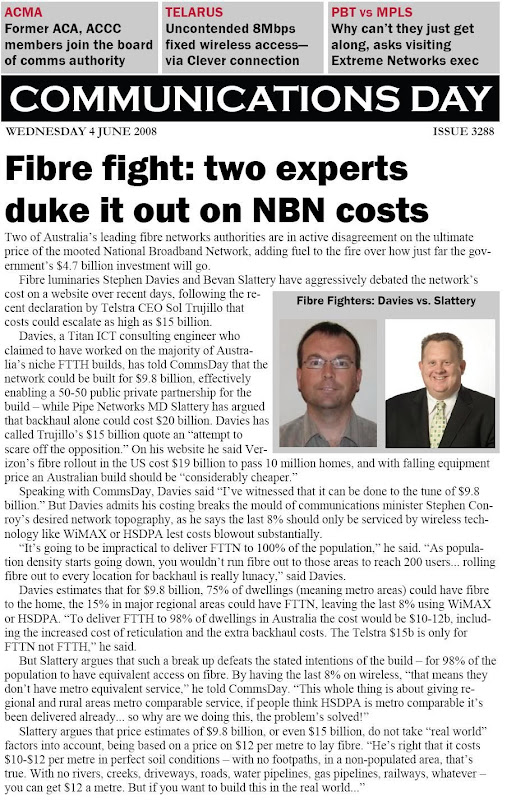For those of you not accustomed to visting Whirlpool - Australia's premier Broadband community forum - there was a great debate over the past two weeks between myself and the CEO of Pipe Networks, Bevan Slattery.
Bevan Slattery has been an enabler of Australia's broadband competitive landscape. Much of the DSL backhaul used by the likes of iiNet, Internet, Adam, Primus, TPG/Soul (and I would also imagine Optus and AAPT/Powertel) is carried over Pipe Network's dark fibre infrastructure. In 2006, his company won ATUG's "Carrier of the Year" award for its significant contribution to Australian business telecommunications.
But in a recent presentation Bevan made to the CommsDay Summit, he slammed the Government over the National Broadband Network; claiming it would cost in excess of $20b just for the backhaul alone, with another $28b for the cost of deploying the Nodes - a total of $48b. He further claims the Labour party is already "breaking its pre-election promises" and "watering down" the NBN after realising the "true cost" of the network was much larger.
Over the past two weeks we have conducted a robust and very public debate on Whirlpool regarding the real cost of the NBN. The debate was based on two critical issues; Coverage Area and Cost of Deployment.
Bevan claims the Government originally promised to deliver a minimum 12Mbps symmetrical service to 98% of the population, representing a coverage area a little over 1 million square kilometres. Based on this 343,728 nodes (at a cost of $85,000 each) would be needed to met the Government requirements; with 687,000 kilometres of new fibre backhaul connecting them to the Internet. This represented a total cost of $48b, significantly more than the $9.4b the Government (and others) has suggested.
As I highlighted in my article and several times during the debate, Bevan made three critical mistakes in his calculations:
This debate went on for 10 days and was eventually picked up the CommsDay journalist Luke Coleman who published an article called the "Fibre Fight". Luke gave me permission to reprint this article.

Bevan Slattery has been an enabler of Australia's broadband competitive landscape. Much of the DSL backhaul used by the likes of iiNet, Internet, Adam, Primus, TPG/Soul (and I would also imagine Optus and AAPT/Powertel) is carried over Pipe Network's dark fibre infrastructure. In 2006, his company won ATUG's "Carrier of the Year" award for its significant contribution to Australian business telecommunications.
But in a recent presentation Bevan made to the CommsDay Summit, he slammed the Government over the National Broadband Network; claiming it would cost in excess of $20b just for the backhaul alone, with another $28b for the cost of deploying the Nodes - a total of $48b. He further claims the Labour party is already "breaking its pre-election promises" and "watering down" the NBN after realising the "true cost" of the network was much larger.
Over the past two weeks we have conducted a robust and very public debate on Whirlpool regarding the real cost of the NBN. The debate was based on two critical issues; Coverage Area and Cost of Deployment.
Bevan claims the Government originally promised to deliver a minimum 12Mbps symmetrical service to 98% of the population, representing a coverage area a little over 1 million square kilometres. Based on this 343,728 nodes (at a cost of $85,000 each) would be needed to met the Government requirements; with 687,000 kilometres of new fibre backhaul connecting them to the Internet. This represented a total cost of $48b, significantly more than the $9.4b the Government (and others) has suggested.
As I highlighted in my article and several times during the debate, Bevan made three critical mistakes in his calculations:
- Using population instead of Dwellings. The Labour Party policy document titled "New Directions for Communications" published in March 2007 never used the term population; it quite specifically used the terms dwellings and households, and for a very good reason. There is a major difference in reaching 98% of population (which is typically used for mobile coverage) than 98% of households.
Where Bevan (and many others) made his mistake, was the use of a term in the press release which launched the policy. The term "Australian's" was interpreted by many to mean population, and thus it was mistakenly reported this way by the media.
Doing some calculations using ABS census data from 2006, 75% of the population is located within 23,000 square kilometres, but 75% of households are located within just over 10,000 square kilometres. - Coverage area. To come up with the required 343,728 nodes and 687,000 kilometres of backhaul, Bevan assumed that the entire 1 million square kilometres would need nodes spaced 2 kilometres apart, creating a 4 square kilometre coverage area per node. But instead of using 4 kilometers in his calculation, a figure of 3 kilometres was used; thus creating a distortion of 93,728 nodes.
Furthermore, the basic calculation assumed blanket coverage, but as we well know Australia is a very urbanised country and there are many hundreds of kilometres to run between communities - areas where no nodes would be required. In reality only 37,500 nodes are need to meet the requirements of the tender; costing less than $4.5b and another $2.5b in backhaul. - Building the backhaul. The backhaul was the most significant part of the debate. The discussion surrounded the cost per metre and the construction techniques that could be used to install fibre. In such a large project the cost of laying fibre could be as low as $10 per metre, but more likely to be around the $15 per metre using advanced direct buried installation methods. I have published some photos taken by a colleague of mine, Mike O'Neil - the former project engineer at IP1 - showing the direct bury installation method, and why it can be performed so cheaply.
You can view the slideshow at here.
This debate went on for 10 days and was eventually picked up the CommsDay journalist Luke Coleman who published an article called the "Fibre Fight". Luke gave me permission to reprint this article.
Labels: NBN, PipeNetworks, TitanICT
1 comments:
- At 27 February, 2009 14:05 Anonymous said...
-
Just to clarify, Adam does not use any backhaul by PIPE they use SILK/Nextgen.
Subscribe to:
Post Comments (Atom)

